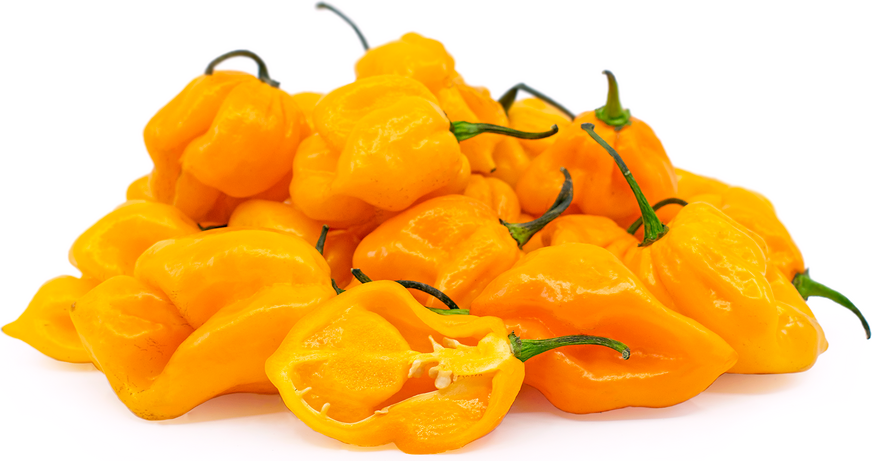


Yellow Scorpion Peppers
Estimated Inventory, 8 ct : 0
Description/Taste
Yellow Scorpion chile peppers are gnarled pods, averaging 7 to 10 centimeters in length and 4 to 6 centimeters in diameter, and are deeply creased, sometimes tapering to a small point on the non-stem end. The skin is smooth, shiny, and taut, ripening from light green to bright yellow when mature. Underneath the surface, the flesh is crisp and yellow, encasing a central cavity filled with small, round, and flat, cream-colored seeds. Yellow Scorpion chile peppers have a citrus-forward, sweet, and fruity flavor that transitions into intense, lingering heat.
Seasons/Availability
Yellow Scorpion chile peppers are available in the mid-summer through winter.
Current Facts
Yellow Scorpion chile peppers, botanically classified as Capsicum chinense, are an extremely hot, rare variety belonging to the Solanaceae or nightshade family. Known by other local names, including Yellow Trinidad Moruga Scorpion or simply Yellow Moruga, Yellow Scorpion chile peppers are native to Trinidad, where they are cultivated on a small-scale in home gardens. They are also sometimes referred to as a CARDI variety, named for the research station where the variety was bred and developed. Yellow Scorpion chile peppers rank slightly lower on the Scoville scale compared to their red counterparts, averaging 800,000-1,200,000 SHU, but depending on the growing conditions and stress placed on the plant, some pods may peak in intensity well above the average. The hot peppers are rarely consumed raw and are more popularly used in salsas, hot sauces, and marinades.
Nutritional Value
Yellow Scorpion chile peppers are an excellent source of vitamin C and contain beta-carotene, which is a phytonutrient that gives the pepper its yellow hue and converts to vitamin A in the body. The hot pepper also contains high levels of capsaicin, the compound responsible for its fiery bite, which has antioxidant and anti-inflammatory properties.
Applications
Yellow Scorpion chile peppers are best suited for both raw and cooked applications, but the pods are used sparingly, and a little goes a long way. It is recommended to wear gloves and goggles when handling the peppers as the high capsaicin content can irritate the skin and eyes. Yellow Scorpion chile peppers are popularly blended into hot sauces, marinades, and dips for added flavor and spice. The fruity, citrus-forward flavor of the pepper is versatile and can be mixed into stews, soups, chilis, and casseroles, fish-based dishes, rice, beans, and fresh salads. The peppers can also be roasted before blending into sauces for a richer, savory flavor. In addition to using fresh or cooked, Yellow Scorpion chile peppers can be dried and ground to make a spicy chile powder. Yellow Scorpion chile peppers pair well with peas, carrots, bell peppers, green onions, garlic, potatoes, okra, beans, rice, coconut milk, mango, pineapple, and meats such as fish, poultry, beef, and pork. Yellow Scorpion chile peppers will keep 1-2 weeks when loosely wrapped in plastic and stored whole and unwashed in the refrigerator.
Ethnic/Cultural Info
Yellow Scorpion chile peppers are rare outside of their native home of Trinidad, but within the island nation, the peppers are popularly used fresh or are blended into chile sauces, which are a table condiment for everyday dishes. When used in hot sauce, the peppers are blended with lemon or lime juice to create a tangy, fruity, and spicy combination, and the sauce can be drizzled over macaroni pie, seafood, pasta, and roasted meats. Yellow Scorpion chile peppers can also be used sparingly in salads and salsas. Saltfish buljol is a breakfast dish that is commonly made with Yellow Scorpion chile peppers, consisting of cod with tomatoes, hot peppers, bell peppers, and onions mixed together to create a salad-like consistency, traditionally served over bread, crackers, or baked goods. Yellow Scorpion chile peppers can also be finely chopped and added to a salsa known as the “mother-in-law.” This slaw-like salsa is filled with hot peppers, onions, green mango, citrus, and garlic, and is served as a condiment over pelau, one of the most popular rice dishes of Trinidad mixed with peas, peppers, and meat.
Geography/History
Yellow Scorpion chile peppers are native to Trinidad, a small island nation off the coast of Venezuela in South America and are named after Moruga, the district from which they were bred. The production and sale of Yellow Scorpion chile pepper seeds are primarily controlled by the Caribbean Agriculture Research and Development Institute, CARDI, in Trinidad, where the pepper was continually studied and improved to create a stable variety. Today the peppers are rare outside of home gardens in Trinidad but can be found through select specialty farms in North America, Central America, South America, and Australia.
Recipe Ideas
Recipes that include Yellow Scorpion Peppers. One
| Chili Pepper Madness |
|
The Hottest Damn Hot Sauce I've Ever Made! |




